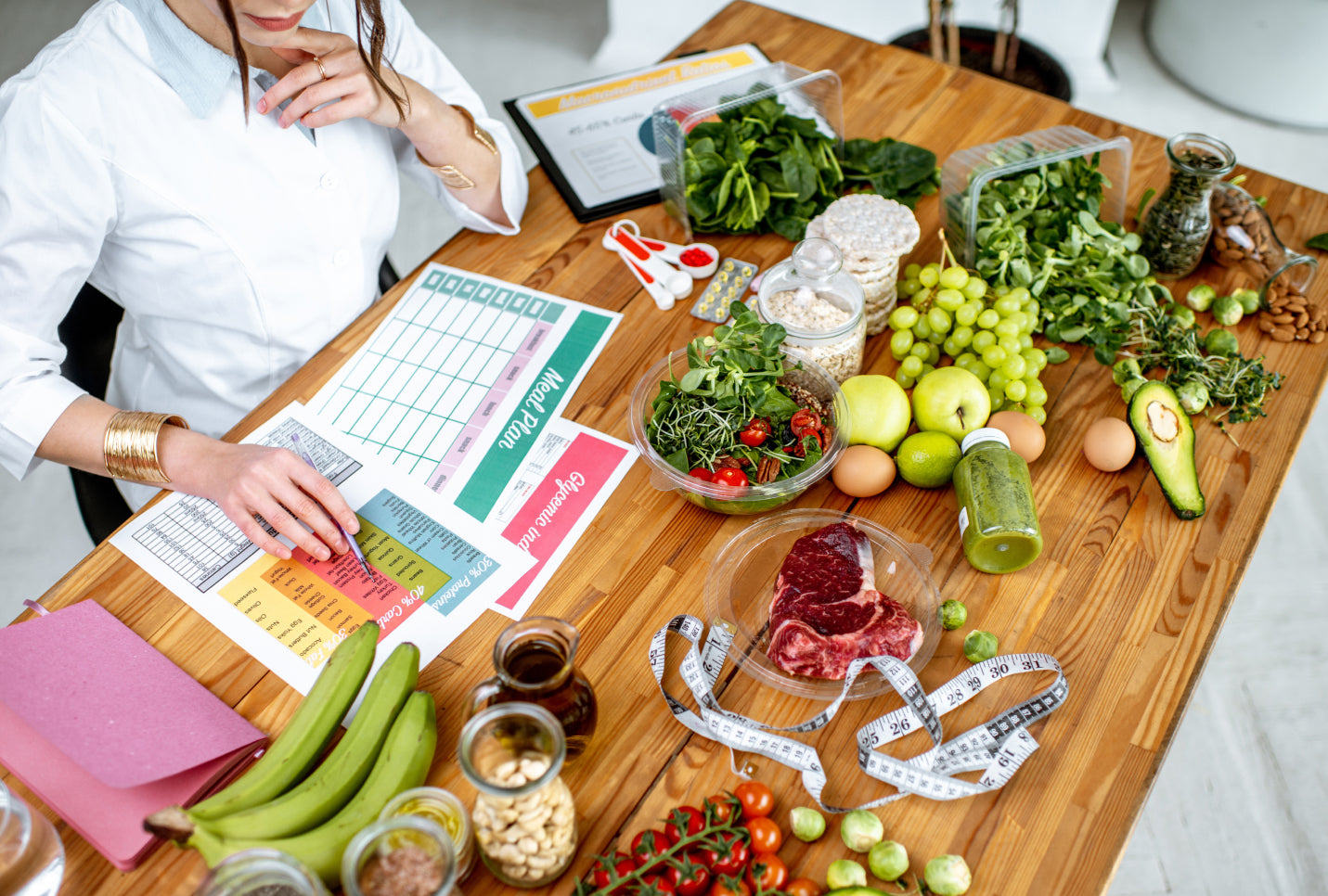
How To Meal Plan: A Beginner's Guide to Simple Planning
Taking control of your diet can often feel like a daunting task, especially with the pressures of everyday life. However, a well-organized approach to eating, such as meal planning, can help ease this burden while encouraging healthy eating habits, reducing food waste, and even saving money.
Whether you're a busy parent, a working professional, or just wanting to lose weight, meal planning can be a transformative tool for your lifestyle. This beginner's guide will help you navigate the ins and outs of meal planning, providing handy tips and insights.
So, gear up to harness the power of planning to revolutionize your dietary habits, from easy meal options to delicious dinner ideas.
What Is Meal Planning?
Meal planning is the act of organizing your meals in advance, typically for the upcoming week. The process involves deciding what you're going to eat for each meal, creating a grocery list of needed ingredients, shopping at the grocery store, and often prepping some components or entire meals ahead of time.
The degree of planning can vary based on your schedule, preferences, and cooking habits. Some people may choose to plan meals for every single day of the week, including breakfast, lunch, dinner, and snacks. Others might just focus on dinner ideas for weeknights when time is often more restricted.
What Are the Benefits of Meal Planning?
One of the significant advantages of meal planning is that it can help encourage healthy eating habits. By planning your meals, you can ensure a balanced diet that includes all the necessary nutrients. This way, it's easier to include fresh fruits, veggies, whole grains, and lean proteins in your diet.
Meal planning can also help to reduce food waste. By planning your meals around what's already in your pantry and making a precise grocery list, you only buy what you need. This not only reduces waste but can also save you money.
Also, meal planning can take the stress out of deciding what to eat each day. Having a plan in place eliminates the last-minute scramble to put together a meal. You already know what you’re having and don’t have to worry about cooking anything.
The Role of Dietary Guidelines in Meal Planning
Dietary guidelines play a crucial role in meal planning. These guidelines, often suggested by a dietitian or found in credible health sources, provide information about the necessary nutrients for a balanced diet and the recommended intake of different food groups.
Following these guidelines can help shape your meal plan by providing a framework to ensure you're meeting your dietary needs. For instance, you may want to include a certain amount of fruits, vegetables, or whole grains each day. By using specific guidelines, you can develop meal ideas that not only taste good but also fuel your body appropriately.
Taking advantage of dietary guidelines while meal planning is a proactive step toward healthier living. By planning your meals, you can achieve a balanced diet, save time, and even add an element of fun to your weeknight dinners.
How Can You Start Meal Planning?
Embarking on your meal planning journey starts with a simple step — deciding what you want to eat for the week ahead. You can use a paper planner, a digital calendar, or even a mobile app to jot down your plans.
When starting, consider the time you have available for cooking. If your schedule is packed, you might want to opt for easy, quick-to-prepare healthy meals. On the other hand, if you have more time at your disposal, you might want to try out more time-consuming, elaborate recipes.
Meal Planning Tips for Beginners
The key to successful meal planning is keeping it simple and flexible. Start with planning just a few days at a time, then gradually increase as you get more comfortable. Also, it's important to factor in days when you might eat out or have a free meal day where you give yourself a break from cooking.
Another tip is to plan for leftovers. Cooking in bulk and using the leftovers for lunches or dinners on subsequent days can save you both time and effort. For instance, large dishes can be made in big portions and then divided into multiple meals.
Choosing Your Meals: From Healthy Recipes to Favorite Dinners
Selecting the meals you want to include in your plan can be one of the most fun aspects of meal planning. Look through your collection of recipes, search websites online, or peruse cookbooks to find meals that appeal to you and fit into your dietary goals.
It’s a good idea to keep a list of favorite recipes that you know your household enjoys. These can quickly fill in any gaps in your plan and save you the trouble of finding new recipes every time.
Remember to consider the balance of your meals. Aim to include a variety of foods in your diet to ensure you're getting a broad spectrum of nutrients. A mix of lean proteins, whole grains, fruits, vegetables, and healthy fats can make for balanced, nutritious meals.
Incorporating New Recipes and Trying Theme Nights
Once you're comfortable with meal planning, it can be fun to spice things up a bit. Trying out new recipes or implementing theme nights can add an element of excitement to your meal plan. Theme nights, like “Meatless Monday,” “Taco Tuesday," or "Pasta Thursday," not only make menu planning easier but also give you something to look forward to.
Creating a Weekly Meal PlanTemplate
As you get into the rhythm of meal planning, creating a weekly template can be a helpful tool. A template can streamline the planning process and save you time each week. You simply have to fill in the template with the meals for each day, making adjustments as necessary based on your schedule for the next week.
Remember, meal planning is meant to make your life easier, not more stressful. So, keep it flexible and adaptable to your needs. It's about finding a system that works for you and helps you incorporate more healthy food into your life effortlessly.
How Can You Grocery Shop for a Meal Plan?
Grocery shopping for a meal plan is an essential step in your meal planning journey. This involves creating a comprehensive grocery list based on the meals you've decided on for the week.
As you start putting together your meal plan, write down the ingredients you'll need for each recipe, ensuring you've covered everything from main ingredients to seasonings.
Pay attention to ingredients you might already have in your pantry or fridge, and avoid buying items you already have.
How To Create an Effective Shopping List
An effective shopping list is the cornerstone of successful grocery shopping. Start by organizing your list by categories, such as:
- Fruits
- Vegetables
- Dairy
- Meats
- Gains
- Others
This not only makes your shopping experience smoother but can also save you time navigating the grocery store aisles.
Before you finalize your list, do a quick inventory of your kitchen. This step ensures you don't buy duplicates of items you already have. Also, consider the quantity of each item you'll need based on your meal plan.
Furthermore, try to stick to your list when you're at the grocery store. This will help you avoid impulse buys, which often tend to be less healthy options.
Grocery Shopping Tips
First, never shop on an empty stomach. Studies have shown that when people shop hungry, they are more likely to buy high-calorie, less healthy foods.
Second, shop the perimeter of the store. That's typically where the freshest ingredients, like fruits, vegetables, meats, and dairy products, are located. The middle aisles usually contain more processed foods. However, exceptions do exist — for example, the aisles with whole grains, beans, and spices — so don't completely ignore the middle.
Finally, consider buying in bulk items that have a long shelf life and are frequently used in your meals. Items like whole grains, canned goods, or frozen veggies can be cost-effective when bought in larger quantities.
How To Avoid Unhealthy Fast Food and Takeout
Meal planning is a great strategy to help you avoid the convenience trap of fast food and takeout. When you have a plan and the ingredients ready, it's easier to resist the urge to order out.
Prepare some easy meal ideas for the days when you're too tired or busy to cook a complicated dinner. Quick and healthy options could include stir-fryveggies, grilled chicken salads, or quinoa bowls.
Furthermore, having a variety of healthy snacks on hand can also help curb those instant hunger pangs that often lead to unhealthy food choices. Fresh fruit, nuts, yogurt, or homemade granola bars can be great options.
Remember, the goal of meal planning is not just to make your life more organized but also to help you make healthier food choices and reduce the reliance on fast food and takeout.
How Can You Make Meal Prep More Convenient?
Convenience is a crucial aspect of meal planning. After all, the goal is to make your life easier, not harder. One way to do this is by dedicating a specific time each week to meal prep. This could be a Sunday afternoon or any other day that works best for you.
During this time, you could prepare and portion out your meals for the week, chop vegetables, marinate meats, or cook certain elements in advance. For instance, quinoa or brown rice can be cooked and stored in the fridge for multiple meals throughout the week. Similarly, you can wash and chop veggies for quick stir-fries or salads.
Batch cooking is another method to save time. Prepare large quantities of a particular meal and divide it into portions for future use. Casseroles, stews, and soups are excellent choices for batch cooking.
Essential Meal Prep Tools: From Instant Pots to Storage Containers
Certain tools can greatly enhance your meal prep experience. An Instant Pot, for example, can significantly reduce cooking time for many dishes. Slow cookers are another beneficial appliance that allows for "set it and forget it" cooking, perfect for busy individuals.
High-quality storage containers are essential for preserving the freshness of your prepped meals. Opt for glass containers, which are not only durable but also free from potentially harmful chemicals found in some plastic containers.
A good set of sharp knives, cutting boards, measuring cups and spoons, and mixing bowls are also integral to a seamless meal prep process.
The Role of Cooking Methods in Meal Planning: Stir Fry, Slow Cooker, and Sheet Pan
The method of cooking can play a significant role in meal planning. For example, stir-frying is a quick and easy method perfect for weeknight dinners, while slow cooking can be beneficial for preparing meals in advance.
Sheet pan meals, where you cook everything together on a single pan, can also be a huge time-saver. Remember that you’ll be cooking for several days in advance. Try anything that can help you save time while cooking.
The Importance of Proper Food Storage
Proper food storage is crucial to maintain the freshness and quality of your meals. Always cool your food properly before storing it to prevent bacterial growth.
Refrigerate or freeze your meals in airtight containers to preserve their taste and prevent contamination. Furthermore, practicing first-in, first-out rotation in your fridge ensures nothing goes to waste.
How Can You Meal Prep for Dietary Needs and Weight Loss?
Meal prep can be particularly beneficial if you're trying to meet specific dietary needs or manage weight.
Count Your Calories
By preparing your meals in advance, you have full control over portion sizes and ingredients, making it easier to count calories and manage your nutritional intake.
Work With a Professional
Consider working with a dietitian or nutritionist to create a meal plan that meets your unique dietary needs and wellness goals.
Why It Works
Meal prep works because it takes the guesswork out of eating healthy. It eliminates the need for last-minute unhealthy food choices and allows you to stay on track with your dietary goals.
Simplifying Your Life with Meal Prep
Meal planning and prep is a powerful tool in your journey toward a healthier lifestyle. It's all about making healthy eating simpler and more convenient. With a bit of practice and the right tools, meal planning can become an enjoyable and rewarding part of your week.
If you’re looking for a few recipe ideas, then feel free to check out some of Dr. Kellyann’s weekly meal plans. Remember, it's not about perfection but rather about making better choices more consistently. Bon Appétit!
Sources:
The Basics: Six Essential Nutrients | Health and Wellness | Washington State University
Food Waste | The Nutrition Source | Harvard University
Dietary Guidelines for Americans Guidelines and Key Recommendations | NCBI Bookshelf
The Hidden Dangers of Fast and Processed Food | PMC
Cooling Hot Food, Do It Right To Prevent Bacterial Growth | Michigan State University








